Change in Material Per Turn

This chart is based on a single playout, and gives a feel for the change in material over the course of a game.
Capture the centre.
Players Black and White begin the game with an equal quantity of pieces, arranged randomly around the edge of the board, but with rotational symmetry.
Each turn, a player moves one piece like chess Queens; however, unlike in chess, they must end their move on a band (denoted by colour) closer to the Throne.
A stone flanked by two opposing stones (either orthogonally or diagonally) is captured and defects to the other player.
When a player makes a frame (a rotationally-symmetrical arrangement of four stones at any distance) around the throne (centre square), they claim it by placing a king there.
The Throne may change hands any number of times in the course of play.
The game ends whan a player has no available moves on their turn.
The winner is whichever side controls the throne at that point.
If the Throne remains neutral throughout, the game is drawn.
General comments:
Play: Combinatorial
Family: Combinatorial 2012
Mechanism(s): King of the Hill
Components: Board
| BGG Entry | Morelli |
|---|---|
| BGG Rating | 7.27803 |
| #Voters | 66 |
| SD | 1.6672 |
| BGG Weight | 3.5 |
| #Voters | 6 |
| Year | 2011 |
| User | Rating | Comment |
|---|---|---|
| icarusmustburn | 8 | |
| karlhanf | 7 | |
| pseudokojo | N/A | Debuted |
| donaldrnelson | N/A | Want |
| noahm | 10 | |
| mrraow | 5 | This seems to be a game about moving as slowly as possible towards the middle. Brrr! |
| arian | 7 | |
| Zubbus | 1 | |
| Markus Hagenauer | 8 | |
| fogus | 7.5 | 2016 ==== I'll admit that I didn't like Morelli at first. However, after a few games the subtleties of the game started to reveal themselves and little by little my appreciation has grown. At first we played it as a Breakfast Game, but as we've come to discover its tactical and strategic depth it's grown into a Open School Night game. That said, I like it much more than my family so these days most of my plays occur online. |
| raphaell7 | 6.5 | |
| FauxSloMo | 8 | |
| vstjrt | 8 | |
| mocko | 10 | Designer rating, but one for which I make no apology. Life's too short for diplomatic deprecation - which in any case is almost always tactical to a greater or lesser extent. Morelli has proved its quality time and time again (to me, at any rate) in the course of many games at BoardSpace, Little Golem and elsewhere. It's subtle, tense and endlessly varied. It's classical in its design - fundamentally simple, in fact - yet also original in several different ways. It takes a while to play, but the same goes for most of the noble abstracts. How does it measure up against the best pure-skill boardgames ever invented by identifiable individuals? Well, what would that have to mean? Better than Amazons, Othello, Lines of Action? Actually I suspect so, in all three cases. Better than Slither or Arimaa or (one I've just been introduced to) Emergo? Not so sure there, but you're already up in the stratosphere if that's where you're looking. |
| megamau | 7 | I like the smaller board variants at little Golem. The original 13x13 board makes games drag too long in my view. |
| fuchsundbrunnen | 8.6 | |
| Reamax | 8 | |
| ypaul | 8 | Morelli is a bizarre game with a very unique 'occupying the throne' condition. It is sort of an area-control game but rather than controlling regions of a board, you're trying to make it such that you can occupy four squares that are rotationally symmetric about the centre, which would give you the throne at the centre of the board. It's a bit of a subtle point, but what you're trying to keep is the 'potential' to make these formations, rather than actually making them because the objective of the game is to be the one to occupy the centre at the end of the game. It takes a while to properly get into it, but once you do, you'll realise that it is a very challenging game with a lot to think about. It's worth a try. |
| touchstonethefool | 6 | |
| Tolkana | 5 | |
| r56ygf | 7 | |
| orangeblood | 6 | This has some unique and appealing elements: the movement, capture rules, and the colorful board among them. But after many games, I am finding its just not very fun to play. It is a brain-burning puzzle, and I dont much like staring at the board for a long period of time just trying to figure out what my opponent may be thinking. In fairness, these comments are based on playing several games simultaneously on Little Golem, and its probably easier to keep track of things with only one game running. |
| CarrollJeff | 10 | This game is easy to learn and profound. The tension builds up early and keeps increasing to the end where you may have to gain time and avoid forced moves to be able to crown the last winning move. The symmetry feature of the rule gives each move an holistic value. |
| Ivers0n | 7 | |
| at010 | 7 | |
| kazk | 8 | |
| Bonejar | 4 | Have been playing on Vassal. Don't really enjoy. Somewhat of a Morris-Kensington kind of thing, but more complex. Would be willing to try again though. |
| Necroblaster3000 | 7 | |
| jegrasso | N/A | memfarita |
| jmastill | 8 | |
| The Player of Games | 8 | Interesting abstract game with unique goal and play. May raise in rating with more plays. |
| Colonnello Vincent | 7.5 | |
| XMJA | 9 | |
| stepanzo | 8.5 | |
| schmozart | 9 | Excellent game, strategic and deep, uniting mechanisms from Quod, Reversi, and Hnefatafl. Probably too hard to play with kids, also the playing material (nestorgames) seems a bit too small. Otherwise wonderful. |
| dispatch134711 | 8.2 | Morelli is a visually fascinating game. The win condition is one based on creating a pattern with four fold rotational symmetry around the center, which promises to be brain burning. The custodian capture rule makes brings dynamism and tension, and the movement rule stating that pieces must move to a closer 'ring' makes the game finite, although draws are possible. I like the novelty and colour, and Tablut-like custodian capture is becoming more common in capture type games, and I think works well here. You can only capture one piece at a time, which stops their being too much negative feedback, like Othello. |
| clark94 | 8 | What a good game Morelli is. The rules are rather complicated for a beginner but this came be remedied by starting on the inner rings. Interesting and thoughtful endgames occur that will test your brain power. The Nestor Version looks amazing also. |
| preve | 7.5 | |
| CDRodeffer | 8 | Interesting game! I need to play it again to get a better feel for it, but it starts out a lot like Ming-Mang, except that parity of square formations determines who is in the lead. It was played at my annual tournament of abstract strategy games several times, and was well received. "There's a lot going on to think about with this game," was the general consensus among the players. My older son tried an interesting strategy in a game with the "adjacent" starting set-up. He took quick control of the center, then attempted to capture any of my pieces that moved into his connected corner in order to build out from that corner anchor to occupy or blockade more than half of the board along each of those two adjacent sides. By doing so, he would be able to prevent me from forming a square by denying me any access to a fourth point. The strategy almost worked, and would have had I not been able to establish a few living pieces outside his range of movement. From then on, I had to patiently wait with small moves on the other edges, setting up as many possible squares as I could. When he was finally starved of moves, I was able to follow through to make square only once. But since I waited until the point when he was unable to form another square, I won. Still, it's certainly a strategy worth exploring in more depth. Recently, I've been playing (and watching) more games with the opposed setup. It can lead to longer games, but the tactics are very sharp with that setup. I don't know how strong it is, but an interesting opening is to move your corner across the center to block in your opponent's corner. It sacrifices the piece for sure, but may buy time to set up the first square. |
| mxpf | 8 | |
| grasa_total | 7 | That is a weird meal all right. Not sure I'm qualified to rate it. The need to have your pieces spread out across the board to claim the throne pushes you in one direction, safety in numbers pushes you in another, I get that, but the constraints imposed by the color system are not at all clear after one play. Liked it, though. |
| ceenan | 8 | |
| ddyer | 7.5 | |
| russ | 7 | |
| tsaito | 7 | |
| srlindemann | 6 | |
| scih | 6 | |
| Arcanio | 10 | |
| pulla | 6 | Deep and tricksy. |
| galbolle | 10 | Very tense and enjoyable. Each size offers different challenges, I suspect 11x11 is underrated (or at least, underplayed). |
| nestorgames | 9 | |
| zeder | 7.5 | |
| drbobjack | 6 | |
| jayjonbeach | 8.5 | There is some serious meat on the bones here nice abstract, others have made good points on it already (though I find the designers proposed question a little pompous and though maybe not meant this way its just poor taste imo to even go 'there' as the designer...) I'll just add it seems to me the scoring is very subpar however and a missed opportunity, ie win only by throne occupancy and dismissing everything else such as board positioning and number of captures ie how many pieces someone has left vs. opponent, tiered scoring seems to make sense to me but note this comment is only after a few games and I hate most scoring systems that allow for draw when there are [i]reasonable and logical[/i] options to declare a winner which I find in almost every case there is (even if it is a "minor" victory that is still better than a bluddy anti-climatic draw unless that truly is all that makes sense) [u]Tidbit[/u] - My [i]knee-jerk reaction[/i] top of my head scoring houserule I would consider if after more play it still seems to make sense would be: Throne Occupancy Major Victory 5 points, Combo of better positioning AND more pieces Standard Victory 3 points, better positioning OR more pieces Minor Victory 2 points (here you would have to deem one of these more important since players will split here, likely more pieces unless someone has a majority in purple?). Then you would decide ahead of time whether a Standard Victory is enough to win a match or not, or whether it HAS to be a Major Victory or 6 points, a few ways to skin it here really. Edit - Played a couple more games and was told that draws are apparently rare, I had one in my first 2 games, either 9x9 (more common apparently) or 11x11 (can't remember) UPDATE: 7.5 => 8 Played again on 11x11 and read the rules again a little closer, up to about 5 games now and likely this rating will go up again. I do think my tie was on 9x9, and I can see why now that ties are likely rare. The real Crux of the game is the "Frame" rule, which allows Throne capture really quite readily by just having 4 pieces not just on corners in a regular square or making a diagonally positioned square, but by making ANY square in any position that surrounds the center where the 4 corners are equal distance apart. Wow, okay, so that really opens things up lol. Due to this there probably isn't a good tie-breaking rule, since the Throne can turn on a dime right to the end regardless of many other things. My only possible (but unlikely to be) concerns now are I wonder if it is "too open" (probably not but wow the AP here yikes); and the endgame rule where once one side runs out of moves the game ends (and effectively you can not plan to conserve moves until the end while the other player is playing more/too aggressively. I tried this before reading rules carefully thinking it was a good strategy and then the game abruptly ended when I still had moves left. You can still sort of "conserve" some moves and will absolutely need too at times but it will have be done more carefully and in concert with the opponent, and w/o the rule the game would likely plod along much slower and would be too much about "waiting" and probably not good). On this last topic note if you are currently winning, one legit situational strat possibility will be to eliminate your own moves to end the game before the opponent can create his own Frame Enjoying the depth of this one and the combo of different aspects like capture, blocking, timing importance etc. Bigger boards are going to go far slower, and be even more prone to the already present AP the game induces from having to "cover your ass" 6 ways to breakfast and the high number of ways to capture, and lose, "The Throne" (Game) UPDATE: 8 => 8.5 While it's a little slower (comparatively to some others like some Burm's etc) at times when things get precarious (well, that is most of the game...), it's just quite enjoyable plumbing the depths of this one which is where the time goes, it is very strategic where lots of look ahead is required, likely will end up 9 for me |
| boardlessgamer | 7.5 | |
| Ottia | 10 | Extremely deep and original abstract game that manages to hint at different older games and at the same time walk past them. The goal is to control the central square of the board at the end of the game with pieces that move towards it, but this control isn't exerted in the classic way (i.e. Agon): it will be conquered by building a square of any size around it with the player's own pieces. There is custodial capture and the captured pieces flip and change their colour (i.e. Othello) but mere quantity won't win the game and could in occasions bring it to a too early demise. One very easy setup of pieces around the board is the known one for Ming Mang - it's just one possible setup, though... out of all the possible ones in which pieces are symmetric to the central square of the board. Playing with the "standard" 13x13 board is an extremely satisfying experience. The sheer amount of pieces and their long range of movement at the beginning of the game allow many options to attack or gain early control of the central square. Furthermore, players need to keep constant attention on gaining both material advantage and threatening positions open on the board. A single setup of the game is enough to explore it time and time again - considering all possible setups makes Morelli as good as inexhaustible. |
| slovo | 9 | I'm enjoying this game very much, alt ought my girlfriend likes more simple games like Patchwork, I like the feeling of control I have on this particular game, If I lose I know is my fault and I can see my poor moves with more or less clarity (altought Epaminondas is the paramount of clarity I think), but in Patchwork beside the randomness of the choices available I have no idea of what exactly I did right or wrong, it's fun yes, but Morelli reaches the level of control I want to experience, and it feels like all the pieces are flowing to the center very naturally, some kind of shamanic dance? I`m talking nonsense I guess |
| richgowell | 8.8 | rating is early and provisional, but this game already has me coming back regularly in an effort to master it....or rather, to at least master Dumbot. The four fold symmetry aspect seems fresh and interesting, and the centrality of blocking tactics is fascinating. You must achieve what you will achieve as the decision tree narrows, and pieces are drawn inexorably to their final resting places. All in all a very pleasant surprise. Update: I'm playing 9x9 against both the bot and people, and my estimation of this one is rising. Timing plays an absolutely key role, and I find that this form of the game (9x9) is joining the very top ranks of games I enjoy. |
| Kaffedrake | 6 | An original abstract with several things going on like pattern recognition and creation, custodian conversion, blocking, stalling and move starvation. It does seem to be a game in search of a standard setup, although that is perhaps for the ages to decide. My impression is that 9x9 and Ming Mang setup are not optimal, especially in combination; perhaps alternating [-]pairs[/-] fours? |
| damonstea | 6 | |
| dralius | 7 | |
| _The_Inquiry_ | 5 | Prior to 2020: 1 play |
| Skaboy | 7 | |
| Jugular | 4 | Probably a good deep game but not one I'm enjoying exploring. It has significant cold phases and in early levels of play can have some unsatisfying draws. It's pretty, reintroduces custodial capture and seems like a great game for someone who enjoys Othello or similar. Great for someone else but not me. |
| Takvorian | 8 | Although I am still quite clueless here, I like Morelli very much. It is very different from all other abstracts I played so far. Good thing that it is playable on a 9x9, 11x11 and 13x13 board, without losing its character. So it's easy to adjust the playing time. It has a good chance to enter my top 10 list. |
| Josquin | 8 | |
| glanfam | N/A | Nestor |
| ChristianDK | 4 | |
| Thomas72 | 5 | |
| jmdsplotter | 5.25 |
| AI | Strong Wins | Draws | Strong Losses | #Games | Strong Win% | p1 Win% | Game Length |
|---|---|---|---|---|---|---|---|
| Random | |||||||
| Grand Unified UCT(U1-T,rSel=s, secs=0.01) | 36 | 0 | 0 | 36 | 100.00 | 47.22 | 94.67 |
| Grand Unified UCT(U1-T,rSel=s, secs=0.07) | 36 | 1 | 6 | 43 | 84.88 | 59.30 | 89.02 |
| Grand Unified UCT(U1-T,rSel=s, secs=0.20) | 36 | 1 | 10 | 47 | 77.66 | 45.74 | 83.09 |
Level of Play: Strong beats Weak 60% of the time (lower bound with 90% confidence).
Draw%, p1 win% and game length may give some indication of trends as AI strength increases; but be aware that the AI can introduce bias due to horizon effects, poor heuristics, etc.
| Size (bytes) | 24553 |
|---|---|
| Reference Size | 10577 |
| Ratio | 2.32 |
Ai Ai calculates the size of the implementation, and compares it to the Ai Ai implementation of the simplest possible game (which just fills the board). Note that this estimate may include some graphics and heuristics code as well as the game logic. See the wikipedia entry for more details.
| Playouts per second | 4100.92 (243.85µs/playout) |
|---|---|
| Reference Size | 608383.52 (1.64µs/playout) |
| Ratio (low is good) | 148.35 |
Tavener complexity: the heat generated by playing every possible instance of a game with a perfectly efficient programme. Since this is not possible to calculate, Ai Ai calculates the number of random playouts per second and compares it to the fastest non-trivial Ai Ai game (Connect 4). This ratio gives a practical indication of how complex the game is. Combine this with the computational state space, and you can get an idea of how strong the default (MCTS-based) AI will be.
| 1: White win % | 50.50±2.45 | Includes draws = 50% |
|---|---|---|
| 2: Black win % | 49.50±2.45 | Includes draws = 50% |
| Draw % | 4.08 | Percentage of games where all players draw. |
| Decisive % | 95.92 | Percentage of games with a single winner. |
| Samples | 1595 | Quantity of logged games played |
Note: that win/loss statistics may vary depending on thinking time (horizon effect, etc.), bad heuristics, bugs, and other factors, so should be taken with a pinch of salt. (Given perfect play, any game of pure skill will always end in the same result.)
Note: Ai Ai differentiates between states where all players draw or win or lose; this is mostly to support cooperative games.
Rotation (Half turn) lost each game as expected.
Reflection (X axis) lost each game as expected.
Reflection (Y axis) lost each game as expected.
Copy last move lost each game as expected.
Mirroring strategies attempt to copy the previous move. On first move, they will attempt to play in the centre. If neither of these are possible, they will pick a random move. Each entry represents a different form of copying; direct copy, reflection in either the X or Y axis, half-turn rotation.
| Game length | 83.13 | |
|---|---|---|
| Branching factor | 129.31 | |
| Complexity | 10^152.07 | Based on game length and branching factor |
| Computational Complexity | 10^7.99 | Sample quality (100 best): 17.03 |
| Samples | 1595 | Quantity of logged games played |
| Distinct actions | 2240 | Number of distinct moves (e.g. "e4") regardless of position in game tree |
|---|---|---|
| Good moves | 1019 | A good move is selected by the AI more than the average |
| Bad moves | 1221 | A bad move is selected by the AI less than the average |
| Terrible moves | 22 | A terrible move is never selected by the AI Terrible moves: k12-d5,l5-c5,l5-d5,l5-e5,l5-f11,l8-c8,b11-i4,b6-i6,l7-d7,j2-j11,b12-j4,f11-f4,b2-k11,b9-k9,i12-i3,h2-h11,c6-i6,l9-d9,j2-c9,b8-j8,b10-k10,f12-f3 |
| Samples | 1595 | Quantity of logged games played |

This chart is based on a single playout, and gives a feel for the change in material over the course of a game.

This chart shows the best move value with respect to the active player; the orange line represents the value of doing nothing (null move).
The lead changed on 22% of the game turns. Ai Ai found 0 critical turns (turns with only one good option).
Overall, this playout was 50.00% hot.

This chart shows the relative temperature of all moves each turn. Colour range: black (worst), red, orange(even), yellow, white(best).

Table: branching factor per turn.

This chart is based on a single playout, and gives a feel for the types of moves available over the course of a game.
Red: removal, Black: move, Blue: Add, Grey: pass, Purple: swap sides, Brown: other.
| 0 | 1 | 2 |
|---|---|---|
| 1 | 480 | 222159 |
Note: most games do not take board rotation and reflection into consideration.
Multi-part turns could be treated as the same or different depth depending on the implementation.
Counts to depth N include all moves reachable at lower depths.
Inaccuracies may also exist due to hash collisions, but Ai Ai uses 64-bit hashes so these will be a very small fraction of a percentage point.
No solutions found to depth 2.
| Moves | Animation |
|---|---|
| a1-d4 | 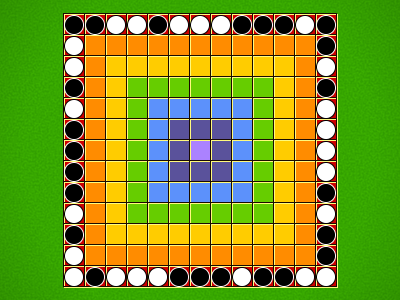 |
| a1-h8 | 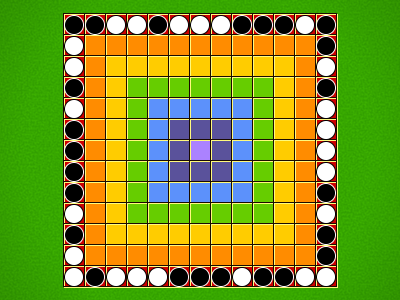 |
| a1-j10 | 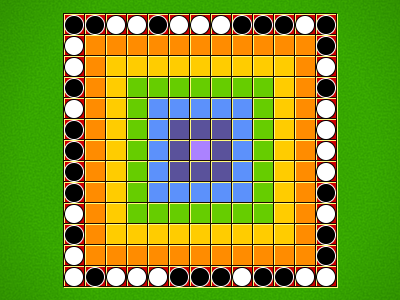 |
| c1-b2 | 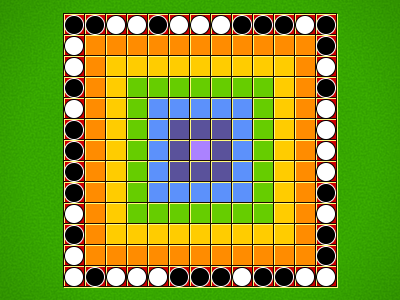 |
| c1-c6 | 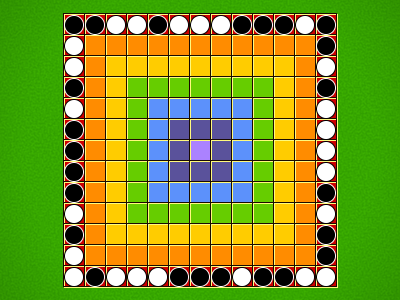 |
| c1-c10 | 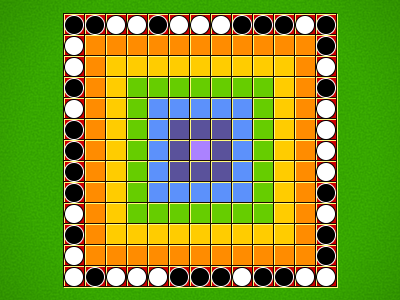 |
| c1-c11 | 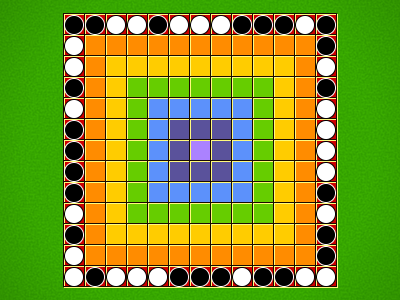 |
| c1-g5 | 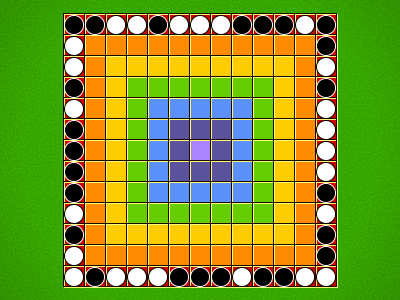 |
| c1-h6 |  |
| d1-c2 | 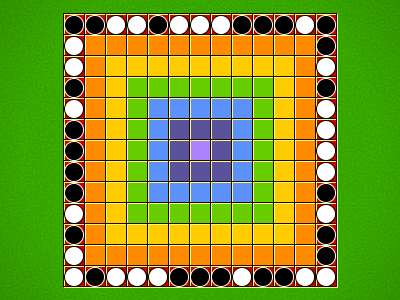 |
| d1-b3 | 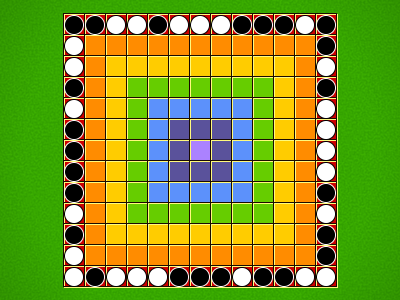 |
| d1-d4 | 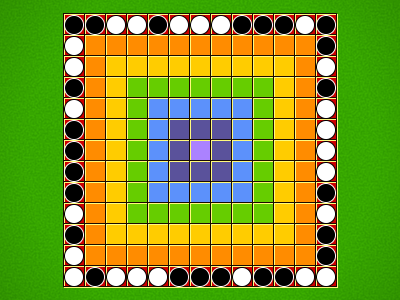 |
| Puzzle | Solution |
|---|---|
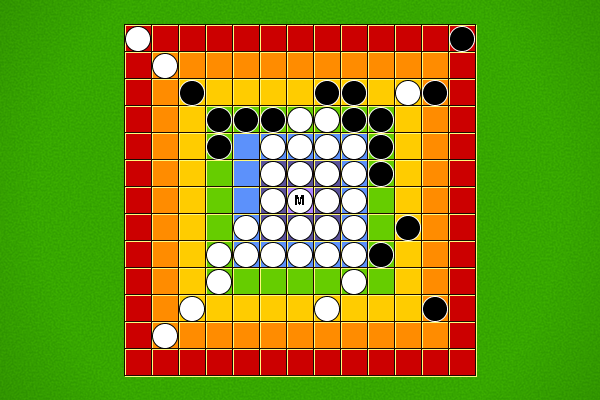 Black to win in 7 moves | |
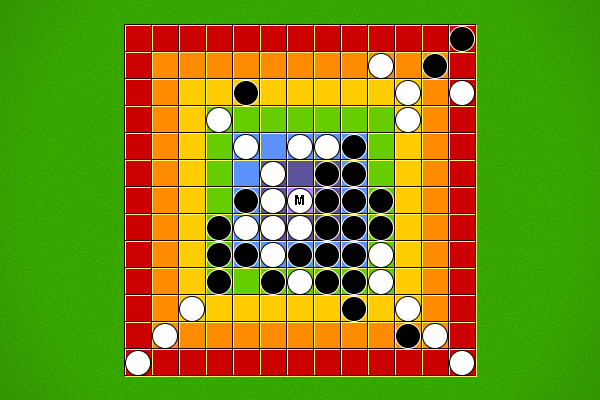 Black to win in 12 moves |
Selection criteria: first move must be unique, and not forced to avoid losing. Beyond that, Puzzles will be rated by the product of [total move]/[best moves] at each step, and the best puzzles selected.